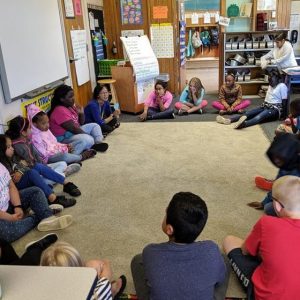Virtual instruction isn’t going away. Let’s make it great.
04/01/2021
Demystifying Virtual Teaching
Schools face challenging decisions about reopening as the coronavirus vaccine becomes more available. Many education and political leaders have concluded that virtual instruction is a poor—if not harmful— substitute for traditional teaching. However, significant numbers of families and teachers do not trust that in-person schooling will be sufficiently safe. That means millions of students will still participate in virtual options next year.
So, how might we focus on getting it right?
I decided to step outside my role as the CEO of Leading Educators and co-teach math part-time to find out. Throughout January and February, I spent 8 hours a week embedded in a school in Houston. Predictably, it has been a big adjustment. More surprisingly, virtual classrooms are outperforming their in-person counterparts.
From these experiences, I have identified four challenges that successful virtual instruction must address and ways that my co-teacher, Ms. S, is modeling how to make it work.
Four Challenges to Great Virtual Instruction
Many educators are overwhelmed by a never-ending cycle of crisis response. It’s no wonder that outstanding virtual instruction feels aspirational. To prevent a sense of paralysis, I suggest centering on four questions.
- Relationships: How can I develop and sustain deep, motivating relationships with students and among students in my virtual classroom?
- Engagement: How can I leverage multiple strategies to engage and re-engage students?
- Rigorous Content: How do I make sure content is still rigorous and challenging?
- Efficiency: How can I best use my time?
These challenges are interrelated, and they require a set of new teaching practices and support for teachers. Here’s how a few ideas are coming together in Ms. S’s classroom.
A Visit to Ms. S’s Classroom
On a recent day, 32 third-graders are practicing how to represent multiplication problems using tape diagrams and using those representations to solve problems in a real-world context. Every student is on camera. Ms. S follows along on Nearpod as they work. Hardly ten seconds go by without Ms. S praising a student’s work, challenging them to think more deeply, or celebrating their participation and collaboration. Class is fun and joyful. Students have clear classroom roles – some are reader leaders, others help troubleshoot technology. Engagement is high, and the content is rigorous.

Ms. S gives ClassDojo points for students being on camera, showing work, or sharing their mathematical thinking. She records these points and sends them to parents for communication about engagement. While they work, Ms. S gives students who are using their phones to participate additional support. A few students call in from loud spaces and when they read, background noise comes through the screen. In these instances, Ms. S warmly re-reads the word problem and asks, “Good math readers do what with word problems? “We read them more than once, “ the class responds in unison. Routines are efficient, and there are incentives for all students to participate however they can.
Throughout the hour lesson, Ms. S uses a variety of applications to observe student work and facilitate conversations among students about mathematics, spotlighting student work on the screen. Since she assesses student learning during each class, there is no question about how students are doing. Once a week, she administers a more formal online assessment. Data show that Ms. S’s students are learning more than their in-person peers and may even be learning more than when they were in person with Ms. S. Timely assessment allows Ms. S to maintain strong relationships and communication with families.
Teachers Need Strong Support, Too
Beyond the classroom, school leaders have provided critical support to set up Ms. S for success. First, they did not assume that strong in-person practices would necessarily carry over into virtual instruction. To adjust, they spent time last spring observing the instructional core – the interactions among students, teachers, and the content.
Second, leaders emphasized simplicity for both families and teachers. Virtual students need only one Zoom link for their day and their classes keep the same schedule each day of the week. Teachers rotate across the Zoom links with other technology apps integrated into Zoom as needed.
Third, the principal has differentiated teaching responsibilities in response to parent choices. After parents select either in-person or virtual instruction each quarter, teachers are assigned to either only one mode. This allows teachers to specialize and build confidence. This also avoids the overwhelming responsibility of trying to teach both in-person and virtually at once – an option that makes engaging instruction for both groups of students challenging.
Fourth, school leaders selected Eureka Math as a high-quality base for instruction. Teachers use curriculum-aligned formative assessments weekly to monitor student learning and plan support. Leaders guide teachers to reflect on student misunderstandings and plan small group learning opportunities. The curriculum and assessments provide a common scoreboard for all staff to track student progress.
Fifth, school leaders encourage teaching teams to collaborate and make modifications. Teachers collaborate on Powerpoint materials that work for both learning modes. They have time to support, troubleshoot, and share resources across the team. There is a feeling that they can meet challenges together and they are trusted to meet their students’ needs with professional expertise.
The Takeaway
Seeing great virtual instruction can change our beliefs about what is possible for students at this time. This doesn’t mean that it will be easy. Not only does great virtual instruction take new practices, but it also requires new kinds of support including collaboration time, technology, and coherent curriculum and assessment. Teachers need the safety and trust to take risks.
One thing is clear: we cannot simply wait out the pandemic. Many families – particularly families of color – will depend on virtual instruction as the primary mode of learning for their children over the next year. If we fail to improve, we risk irreparably damaging the trust of parents and communities in schools. Most importantly, we risk losing the learning and the trust of students who deserve rich, meaningful instruction even amid rapid change. It will not be easy, but how we respond at this moment will impact equity and trust for the next generation.






